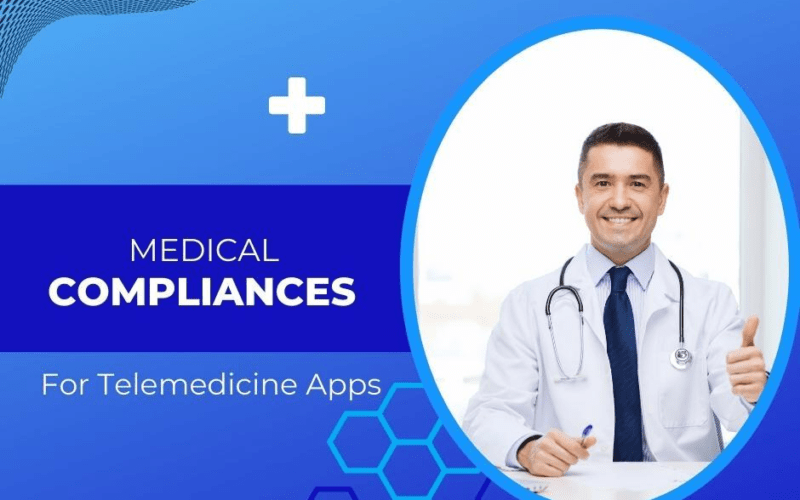
September 29, 2022
The healthcare business is expanding at an astounding rate, and the use of technology is increasing to meet the growing expectations of customers and the healthcare industry. Telemedicine apps and wearable devices are being used to improve the coverage and usefulness of healthcare services.
According to the research firm Statista, the worldwide mobile healthcare industry is expected to reach $100 billion by the year 2021.
The Healthcare business deals with sensitive user data, and in order to provide proper security to preserve the data, Telemedicine apps development must adhere to HIPAA compliance rules. In this post, we will go through HIPAA compliance and the process of creating a Telemedicine app based on the Doctor on Demand app idea.
 The US federal government passed the HIPAA statute (Health Insurance Portability and Accountability Act) in 1996. The HIPAA legislation assures that there are no irregularities in the storage and processing of sensitive patient data. The HIPAA act is a set of standards that healthcare and medical service providers must follow to guarantee that patient data, charts, records, and accounts are kept correctly and securely.
The US federal government passed the HIPAA statute (Health Insurance Portability and Accountability Act) in 1996. The HIPAA legislation assures that there are no irregularities in the storage and processing of sensitive patient data. The HIPAA act is a set of standards that healthcare and medical service providers must follow to guarantee that patient data, charts, records, and accounts are kept correctly and securely.
 You must seek FDA certification if your mobile application assists in the detection, treatment, cure, or mitigation of a health concern. The FDA will evaluate the sort of app you created, such as whether it allows users to download data from a blood glucose metre or acts as a tool to convey information on, say, diabetes management.
You must seek FDA certification if your mobile application assists in the detection, treatment, cure, or mitigation of a health concern. The FDA will evaluate the sort of app you created, such as whether it allows users to download data from a blood glucose metre or acts as a tool to convey information on, say, diabetes management.
What basically is Telemedicine?
Telemedicine refers to the delivery of health care services by all health care professionals using information and communication technologies for the exchange of valid information for disease and injury diagnosis, treatment, and prevention, research and evaluation, and continuing education of health care providers, all in the interests of advancing the health of individuals and communities.Medical Compliance That Telemedicine Apps Need to Follow
1. HIPAA Compliance
 The US federal government passed the HIPAA statute (Health Insurance Portability and Accountability Act) in 1996. The HIPAA legislation assures that there are no irregularities in the storage and processing of sensitive patient data. The HIPAA act is a set of standards that healthcare and medical service providers must follow to guarantee that patient data, charts, records, and accounts are kept correctly and securely.
The US federal government passed the HIPAA statute (Health Insurance Portability and Accountability Act) in 1996. The HIPAA legislation assures that there are no irregularities in the storage and processing of sensitive patient data. The HIPAA act is a set of standards that healthcare and medical service providers must follow to guarantee that patient data, charts, records, and accounts are kept correctly and securely.
2. Health Level 7:HL7 Standards
Your doctor-on-demand app must adhere to the health level seven (HL7) standard, which establishes the structure for the sharing of health-related data. This enables effective data interchange, sharing, and retrieval across medical apps for the delivery of healthcare services.3. Certified with EPCS
EPCS, or electronic prescription of controlled substances, can enhance drug safety, provider efficiency, and patient pain management.4. Electronically Protected Health Information.
Electronically protected health information, or ePHI, is protected health information that is produced, kept, transferred, or received electronically. In the United States, the ePHI administration is governed by the Health Insurance Portability and Accountability Act of 1966 (HIPAA) Security Rule.5. Integrated with EPA
When it comes to remote patient monitoring and home healthcare, every caregiver can rely on EVV technology. Gathering crucial information regarding a house visit can improve its efficacy. An EVV app is used to collect this information on mobile devices.6. FDA Policy for Mobile Medical Applications
 You must seek FDA certification if your mobile application assists in the detection, treatment, cure, or mitigation of a health concern. The FDA will evaluate the sort of app you created, such as whether it allows users to download data from a blood glucose metre or acts as a tool to convey information on, say, diabetes management.
You must seek FDA certification if your mobile application assists in the detection, treatment, cure, or mitigation of a health concern. The FDA will evaluate the sort of app you created, such as whether it allows users to download data from a blood glucose metre or acts as a tool to convey information on, say, diabetes management.
7. HITECH Act Meaningful Use Stage 1 & 2
President Barack Obama signed the Health Information Technology for Economic and Clinical Health (HITECH) Act into law on February 17, 2009. One of the key purposes of the HITECH legislation is to encourage healthcare practitioners to move from paper records to EHRs.8. Health and Human Services Guidelines
The department has a responsibility to guarantee that all individuals seeking information and services from an HHS OpDiv have equal access to and use of such services. We believe that everyone has a responsibility to respect accessibility standards.9. HER and ICD-10
The ICD-10 will have an influence on your EHR strategy and tactics. For many years, the American healthcare system has used ICD-9. It is a coding system used to categorize and identify various illnesses. ScrumDigital is a mobile app development company offering robust app development services that cater to businesses of all sizes in the Healthcare industry.Related Items: mobile app development companyresearch firm Statista





